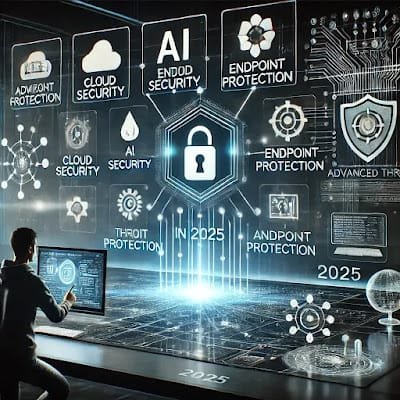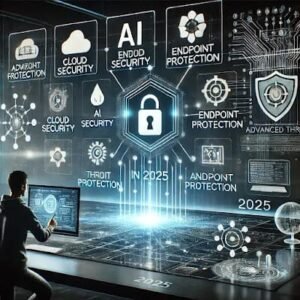Cybersecurity Trends in 2025: How AI-Driven Security Measures Are Shaping the Future
By|TN HEADLINES24
Introduction
As technology keeps advancing, cybersecurity is becoming a top priority for both businesses and individuals. Looking ahead to 2025, cyber threats are becoming more complex, so it’s crucial for organizations to stay ahead with smart, flexible security solutions. To meet these challenges, many businesses are turning to Artificial Intelligence (AI) for support.
In this article, we’ll take a closer look at the Cybersecurity Trends Shaping 2025 and How Companies are using AI-driven tools to protect their data and networks.
The Evolving Cybersecurity Landscape
As businesses continue to embrace digital technologies, they’re facing more complex cybersecurity threats. Traditional security systems often struggle to keep up with these evolving risks, making it essential for organizations to adopt new technologies. Cybercriminals are always finding new ways to exploit weaknesses, and these advanced attacks are expected to become even more widespread and sophisticated.
Looking ahead to 2025, the cybersecurity landscape will be shaped by several key trends:
1. Rise in AI-Powered Attacks
Cyber attackers are using AI and machine learning to create more advanced attack methods, including automated phishing, deepfake technologies, and malware that adapts to avoid detection. These AI-powered attacks are designed to bypass traditional security systems and take advantage of human weaknesses.
2. Increased Focus on Privacy
As privacy concerns continue to grow, especially with data breaches on the rise, organizations are under pressure to adopt measures that protect personal and sensitive information. AI technologies will be critical in identifying and responding to privacy-related threats in real-time.
3. Cloud Security Challenges
The shift to cloud computing and remote work has led to a surge in cloud-related cybersecurity challenges. With more data stored in the cloud, organizations must secure these digital assets against unauthorized access, misconfigurations, and vulnerabilities in third-party services.
4. The IoT Threat
The Internet of Things (IoT) is expanding, with more connected devices being added to business networks. This growth creates more opportunities for cybercriminals to exploit. Because of this, organizations need to make securing IoT devices and their communication channels a top priority.
How AI Is Revolutionizing Cybersecurity
To keep pace with emerging threats, organizations are increasingly relying on AI-driven security measures to protect their networks. AI brings a range of benefits to cybersecurity, enabling businesses to detect and respond to cyber threats more effectively.
Here are some key ways AI is reshaping cybersecurity:
1. Proactive Threat Detection
AI-powered systems can monitor network traffic and user activity in real time. Using machine learning, these systems can quickly spot unusual behavior, like unauthorized access or abnormal file transfers, which could signal a cyberattack. By detecting these threats early, organizations can take action before a major attack happens, helping to minimize potential damage.
2. Automated Incident Response
AI-driven security platforms can automate many tasks traditionally handled by security analysts, such as responding to known threats, isolating compromised systems, and applying patches to vulnerabilities. This automation allows organizations to respond to threats faster and with greater accuracy, minimizing human error and reducing response times.
3. AI-Enhanced Endpoint Protection
With an increasing number of devices being used in the workplace, endpoint security is a critical concern. AI-driven endpoint protection software can analyze the behavior of applications and detect abnormal activities that could indicate a malware infection. By analyzing data from across an organization’s network, AI systems can identify and neutralize threats before they spread.
4. AI for Predictive Analytics
By analyzing vast amounts of data from both internal and external sources, AI systems can predict potential threats before they manifest. Predictive analytics powered by AI allow organizations to stay ahead of emerging threats and implement preventive measures before they impact their infrastructure.
5. Improved Malware Detection and Defense
AI is increasingly being used to develop advanced malware detection systems. Traditional signature-based methods of identifying malware are becoming less effective as cybercriminals evolve their tactics. AI, however, can identify patterns in large datasets and spot new malware variants based on behavioral characteristics, even if they have never been encountered before.
Cybersecurity Best Practices for 2025
While AI-driven security systems are essential, human oversight and best practices remain critical to maintaining a secure digital environment. Here are some cybersecurity best practices organizations should adopt in 2025:
1. Regularly Update Software
Keeping software and operating systems up to date ensures that vulnerabilities are patched, reducing the chances of exploitation.
2. Employee Training
Employees are often the weakest link in cybersecurity. Regular training on recognizing phishing attacks, using strong passwords, and following security protocols can help prevent breaches.
3. Multi-Factor Authentication (MFA)
Using MFA adds an extra layer of protection to accounts and systems, making it harder for attackers to gain unauthorized access.
4. Data Encryption
Encrypting sensitive data ensures that even if it is intercepted, it remains unreadable to unauthorized parties.
5. Secure Remote Access
With remote work becoming the norm, organizations must implement secure virtual private networks (VPNs) and ensure that employees follow strict security protocols when accessing company networks remotely.
TN HEADLINES24 INSIGHTS
As organizations face increasingly sophisticated cyber threats, the importance of AI-driven security measures cannot be overstated. AI offers the potential to revolutionize the way we defend against cyberattacks, but it is not a one-size-fits-all solution. Combining AI with human intelligence and adhering to cybersecurity best practices will be key to staying ahead of attackers in 2025 and beyond.
TN HEADLINES24 READERS’ INSIGHTS
We want to hear from you!
How are you preparing for the evolving cybersecurity threats of 2025?
Have you already implemented AI-driven security measures in your organization?
Share your thoughts and experiences in the comments below.
TN HEADLINES24 BOTTOM LINE
In 2025, AI-powered solutions will play a major role in cybersecurity, offering smarter ways to detect threats, respond automatically, and protect both endpoints and networks. However, as cyber threats continue to grow more sophisticated, businesses will need a balanced approach that combines AI with traditional security practices. By using AI, organizations can improve their defenses, respond faster to incidents, and better protect their digital assets in an increasingly complex online environment.
Disclaimer: The information provided in this article is intended for general informational purposes only. TN NHEADLINES24 makes every effort to ensure the accuracy and reliability of the content, but does not guarantee the completeness, accuracy, or suitability of the information for any specific purpose. The views and opinions expressed are those of the content and do not necessarily reflect the official stance of TN NHEADLINES24. Readers are encouraged to conduct their own research and seek professional advice before making any decisions based on the information presented.


